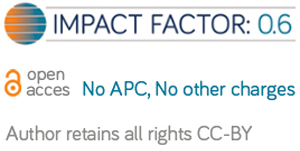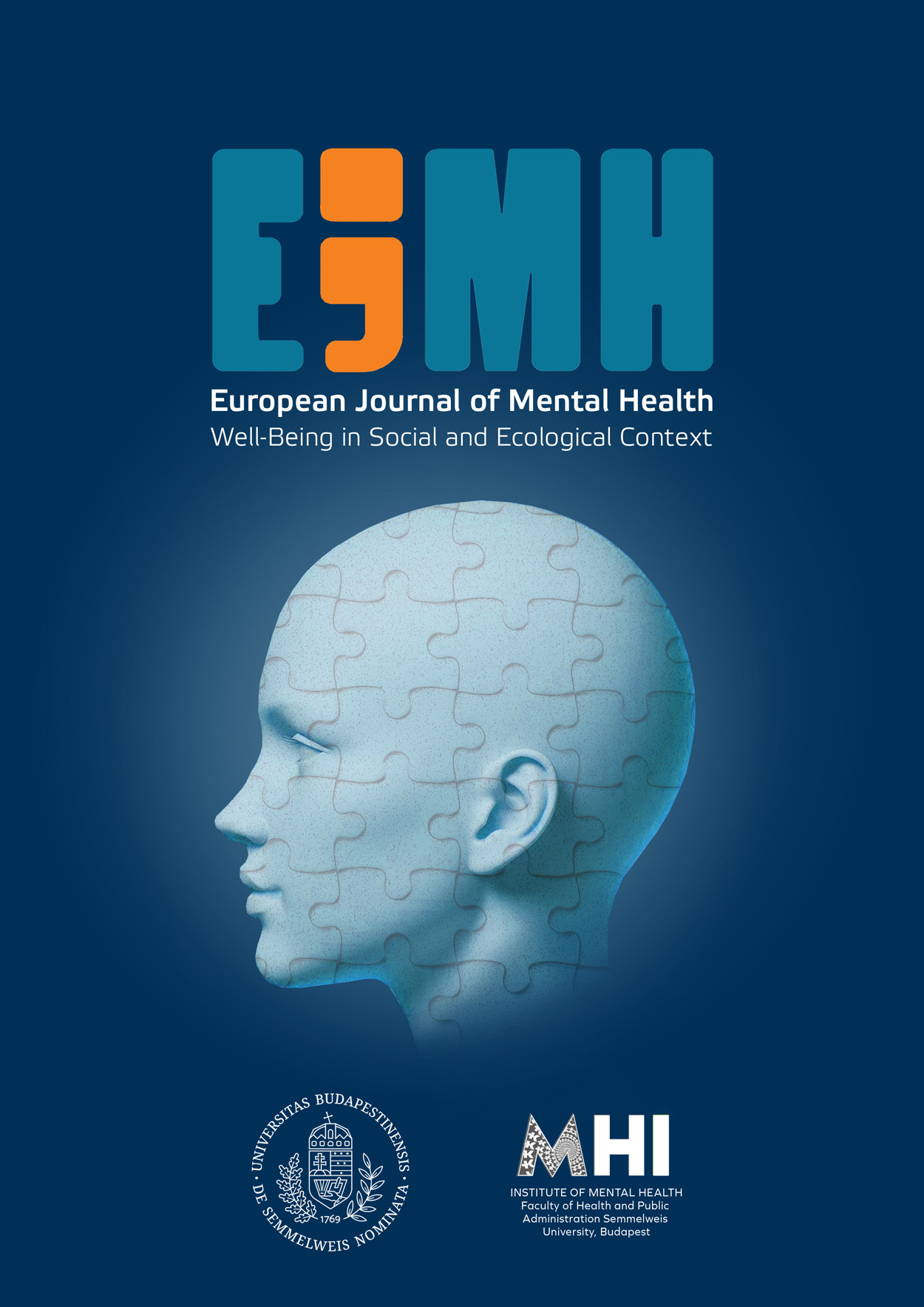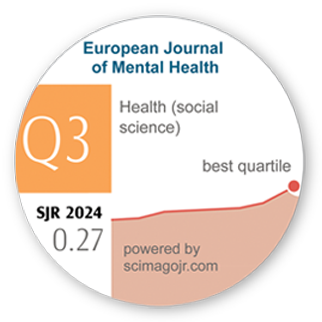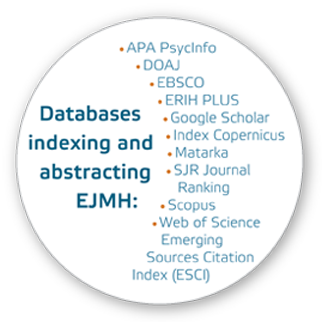The Multifactorial Background of Helping Professionals’ Vital Exhaustion and Subjective Well-Being During the First Wave of COVID-19 in Hungary: A Cross-Sectional Study
DOI:
https://doi.org/10.5708/EJMH.17.2022.2.11Keywords:
vital exhaustion, well-being, health care workers, social workers, helping professionalsAbstract
Introduction: Vital exhaustion and the well-being of helping professionals are important issues regarding the sustainability of services, especially in a critical situation such as the COVID-19 pandemic.
Aims: The purpose of this study was to investigate helping professionals’ vital exhaustion and well-being, concerning different groups of background variables during the COVID-19 pandemic.
Methods: In the spring of 2020, Hungarian helping professionals (N = 931) were contacted with an online questionnaire.
Results: Our results show that indicators of physical well-being are strongly associated with vital exhaustion and subjective well-being (sleeping quality (χ2 (2) = 251.062, p < .001); frequency of meals (χ2 (2) = 99.454, p < .001)). Health and social care workers were more exhausted than members of other helping professions (χ2(4) =37.782, p < .001). There were statistically significant negative correlations between the Vital exhaustion and Well-being Score and satisfaction with work conditions (rs(929) = -.418, p < .001), satisfaction with family life (rs(806) = -.342, p < .001) and its change (rs(807) = -.287, p < .001), family-work balance (rs(675) = -.444, p < .001) and its change (rs(786) = -.515, p < .001). In the prediction of the Vital Exhaustion and the Well-being Score, the addition of physical well-being indicators to the regression model led to the strongest increase in R2 of .344, p < .001.
Conclusion: A clear and consensual framework for life and work provides security amid unpredictable external changes.
References
Alharbi, J., Jackson, D., & Usher, K. (2019). Compassion fatigue in critical care nurses. An integrative review of the literature. Saudi Medical Journal, 40(11) 1087–1097.
https://doi.org/10.15537/smj.2019.11.24569
Alharbi, J., Jackson, D., & Usher, K. (2020). The potential for COVID-19 to contribute to compassion fatigue in critical care nurses. Journal of Clinical Nursing, 29(15-16), 2762–2764.
https://doi.org/10.1111/jocn.15314
Anderson, A. R., & Fowers, B. J. (2020). Lifestyle behaviors, psychological distress, and well-being: A daily diary study. Social Science & Medicine, 263, Article 113263.
https://doi.org/10.1016/j.socscimed.2020.113263
Appels, A., Falger, P. R. J., & Schouten, E. G. W. (1993). Vital exhaustion as risk indicator for myocardial infarction in women. Journal of Psychosomatic Research, 37(8), 881–890.
https://doi.org/10.1016/0022-3999(93)90177-h
Appels, A., Höppener, P., & Mulder, P. (1987). A questionnaire to assess premonitory symptoms of myocardial infarction. International Journal of Cardiology, 17(1), 15–24.
https://doi.org/10.1016/0167-5273(87)90029-5
Arora, T., & Grey, I. (2020). Health behaviour changes during COVID-19 and the potential consequences: A mini-review. Journal of Health Psychology, 25(9), 1155–1163.
https://doi.org/10.1177/1359105320937053
Banks, S., Cai, T., de Jonge, E., Shears, J., Shum, M., Sobočan, A. M., Strom, K., Truell, R., Úriz, M. J., & Weinberg, M. (2020). Practising ethically during COVID-19: Social work challenges and responses. International Social Work, 63(5), 569–583.
https://doi.org/10.1177/0020872820949614
Barello, S., & Graffigna, G. (2020). Caring for health professionals in the COVID-19 pandemic emergency: Toward an “Epidemic of Empathy” in healthcare. Frontiers in Psychology, 11, Article 1431.
https://doi.org/10.3389/fpsyg.2020.01431
Caruso, C. C. (2014). Negative impacts of shiftwork and long work hours. Rehabilitation Nursing, 39(1), 16–25.
https://doi.org/10.1002/rnj.107
Chew, Q. H., Wei, K. C., Vasoo, S., Chua, H. C., & Sim, K. (2020). Narrative synthesis of psychological and coping responses towards emerging infectious disease outbreaks in the general population: Practical considerations for the COVID-19 pandemic. Singapore Medical Journal, 61(7), 350–356.
https://doi.org/10.11622/smedj.2020046
Clarke, M. C., Koch, L. C., & Hill, E. J. (2004). The work‐family interface: Differentiating balance and fit. Family Consumer Sciences Research Journal, 33(2), 121–140.
https://doi.org/10.1177/1077727X04269610
Cohen, R., Bavishi, C., Haider, S., Thankachen, J., & Rozanski, A. (2017). Meta-analysis of relation of vital exhaustion to cardiovascular disease events. The American Journal of Cardiology, 119(8), 1211–1216.
https://doi.org/10.1016/j.amjcard.2017.01.009
Collie, R. J., & Martin, A. (2020, April 7). Teacher wellbeing during COVID-19. Teacher.
https://www.teachermagazine.com.au/articles/teacher-wellbeing-during-covid-19
Comfort, A. B., Krezanoski, P. J., Rao, L., El Ayadi, A., Tsai, A. C., Goodman, S., & Harper, C. C. (2021). Mental health among outpatient reproductive health care providers during the US COVID-19 epidemic. Reproductive Health, 18, Article 49.
https://doi.org/10.1186/s12978-021-01102-1
De Miranda Azevedo, R., Roest, A., Hoen, P., & De Jonge, P. (2014). Cognitive/affective and somatic/affective symptoms of depression in patients with heart disease and their association with cardiovascular prognosis: A meta-analysis. Psychological Medicine, 44(13), 2689–2703.
https://doi.org/10.1017/S0033291714000063
Del Boca, D., Oggero, N., Profeta, P., & Rossi, M. (2020). Women’s and men’s work, housework and childcare, before and during COVID-19. Review of Economics of the Household, 18, 1001–1017.
https://doi.org/10.1007/s11150-020-09502-1
Dodge, R., Daly, A. P., Huyton, J., & Sanders, L. D. (2012). The challenge of defining wellbeing. International Journal of Wellbeing, 2(3), 222–235.
https://doi.org/10.5502/ijw.v2i3.4
Duffy, B., Allington, D., Beaver, K., Meyer, C., Moxham-Hall, V., Murkin, G., Rubin, J., Skinner, G., Strang, L., & Wessely, S. (2020, April 9). Life under lockdown: Coronavirus in the UK. Policy Institue, King’s College London.
https://www.kcl.ac.uk/news/life-under-lockdown-coronavirus-in-the-uk
Ferris, L. T., Williams, J. S., Shen, C. L., O’Keefe, K. A., & Hale, K. B. (2005). Resistance training improves sleep quality in older adults a pilot study. Journal of Sports Science & Medicine, 4(3), 354–360.
Fralick, M., & Flegel, K. (2014). Physician burnout: Who will protect us from ourselves? CMAJ : Canadian Medical Association journal = journal de l'Association medicale canadienne, 186(10), 731.
https://doi.org/10.1503/cmaj.140588
Frestad, D., & Prescott, E. (2017). Vital exhaustion and coronary heart disease risk: A systematic review and meta-analysis. Psychosomatic Medicine, 79(3), 260–272.
https://doi.org/10.1097/PSY.0000000000000423
Fu, W., Wang, C., Zou, L., Guo, Y., Lu, Z., Yan, S., & Mao, J. (2020). Psychological health, sleep quality, and coping styles to stress facing the COVID-19 in Wuhan, China. Translational Psychiatry, 10, Article 225.
https://doi.org/10.1038/s41398-020-00913-3
Galletta, M., Portoghese, I., Ciuffi, M., Sancassiani, F., D’Aloja, E., & Campagna, M. (2016). Working and environmental factors on job burnout: A cross-sectional study among nurses. Clinical practice and Epidemiology in Mental Health, 12, 132–141.
https://doi.org/10.2174/1745017901612010132
García-Carmona, M., Marín, M. D., & Aguayo, R. (2019). Burnout syndrome in secondary school teachers: a systematic review and meta-analysis. Social Psychology of Education, 22, 189–208.
https://doi.org/10.1007/s11218-018-9471-9
Geisler, M., Berthelsen, H., & Muhonen, T. (2019). Retaining social workers: The role of quality of work and psychosocial safety climate for work engagement, job satisfaction, and organizational commitment. Human Service Organizations: Management, Leadership & Governance, 43(1), 1–15.
https://doi.org/10.1080/23303131.2019.1569574
Gorgievski, M. J., Van der Heijden, B. I., J. M., & Bakker, A. B. (2019). Effort-reward imbalance and work-home interference: A two-wave study among European male nurses. Work & Stress, 33(4), 315–333.
https://doi.org/10.1080/02678373.2018.1503358
Greene, T., Bloomfield, M. A. P., & Billings, J. (2020). Psychological trauma and moral injury in religious leaders during COVID-19. Psychological Trauma: Theory, Research, Practice, and Policy, 12 (S1), S143 – S145.
https://doi.org/10.1037/tra0000641
Grossi, G., Perski, A., Osika, W., & Savic, I. (2015). Stress‐related exhaustion disorder–clinical manifestation of burnout? A review of assessment methods, sleep impairments, cognitive disturbances, and neuro‐biological and physiological changes in clinical burnout. Scandinavian Journal of Psychology, 56(6), 626–636.
https://doi.org/10.1111/sjop.12251
Győrffy, Z. (2019). Kiégés és reziliencia (rugalmas ellenállás) a magyarországi orvosok körében [Burnout and resilience among Hungarian psysicians]. Orvosi Hetilap, 160(3), 112–119.
https://doi.org/10.1556/650.2019.31258
Hart, C., & Nash, F. (2020, May 19). Coaching for teacher resilience during COVID-19: Burnout and trauma. RTI International. https://www.rti.org/insights/coaching-teacher-resilience-during-covid-19-burnout-and-trauma
Headey, B., & Wearing, A. (1989). Personality, life events, and subjective well-being: Toward a dynamic equilibrium model. Journal of Personality and Social Psychology, 57(4), 731–739.
https://doi.org/10.1037/0022-3514.57.4.731
Hricová, M., Nezkusilova, J., & Raczova, B. (2020). Perceived stress and burnout: The mediating role of self-care and job satisfaction as preventive factors in helping professions. European Journal of Mental Health, 15(1), 3–22.
https://doi.org/10.5708/EJMH.15.2020.1.1
Huang, Y., & Zhao, N. (2020). Generalized anxiety disorder, depressive symptoms and sleep quality during COVID-19 outbreak in China: A web-based cross-sectional survey. Psychiatry Research, 288, Article 112954.
https://doi.org/10.1016/j.psychres.2020.112954
Ingram, J., Maciejewski, G., & Hand, C. J. (2020). Changes in diet, sleep, and physical activity are associated with differences in negative mood during COVID-19 lockdown. Frontiers in Psychology, 11, Article 588604.
https://doi.org/10.3389/fpsyg.2020.588604
IsHak, W., Nikravesh, R., Lederer, S., Perry, R., Ogunyemi, D., & Bernstein, C. (2013). Burnout in medical students: A systematic review. The Clinical Teacher, 10(4), 242–245.
https://doi.org/10.1111/tct.12014
Janeway, D. (2020). The role of psychiatry in treating burnout among nurses during the COVID-19 pandemic. Journal of Radiology Nursing, 39(3), 176–178.
https://doi.org/10.1016/j.jradnu.2020.06.004
Joshi, G., & Sharma, G. (2020). Burnout: A risk factor amongst mental health professionals during COVID-19. Asian Journal of Psychiatry, 54, Article 102300.
https://doi.org/10.1016/j.ajp.2020.102300
Karhula, K., Koskinen, A., Ojajärvi, A., Ropponen, A., Puttonen, S., Kivimäki, M., & Härmä, M. (2018). Are changes in objective working hour characteristics associated with changes in work-life conflict among hospital employees working shifts? A 7-year follow-up. Occupational and Environmental Medicine, 75(6), 407–411.
https://doi.org/10.1136/oemed-2017-104785
Kopp, M. S., Falger, P. R., Appels, A., & Szedmák, S. (1998). Depressive symptomatology and vital exhaustion are differentially related to behavioral risk factors for coronary artery disease. Psychosomatic Medicine, 60(6), 752–758.
https://doi.org/10.1097/00006842-199811000-00018
Koy, V., Yunibhand, J., & Turale, S. (2020). “It is really so exhausting”: Exploring intensive care nurses’ perceptions of 24‐hour long shifts. Journal of Clinical Nursing, 29(17-18), 3506–3515.
https://doi.org/10.1111/jocn.15389
Kripke, D. F., Garfinkel, L., Wingard, D. L., Klauber, M. R., & Marler, M. R. (2002). Mortality associated with sleep duration and insomnia. Archives of General Psychiatry, 59(2), 131–136.
https://doi.org/10.1001/archpsyc.59.2.131
Kudielka, B. M., Bellingrath, S., & Hellhammer, D. (2006). Cortisol in burnout and vital exhaustion: An overview. Giornale Italiano Medicina del Lavoro Ed Ergonomia, 28(1 Suppl 1), 34–42.
Lewis, C. A., Turton, D. W., & Francis, L. J. (2007). Clergy work-related psychological health, stress, and burnout: An introduction to this special issue of Mental Health, Religion and Culture. Mental Health, Religion & Culture, 10(1), 1–8.
https://doi.org/10.1080/13674670601070541
Liu, S., Yang, L., Zhang, C., Xiang, Y.-T., Liu, Z., Hu, S., & Zhang, B. (2020). Online mental health services in China during the COVID-19 outbreak. The Lancet Psychiatry, 7(4), e17-e18.
https://doi.org/10.1016/S2215-0366(20)30077-8
Lloyd, C., King, R., & Chenoweth, L. (2002). Social work, stress and burnout: A review. Journal of Mental Health, 11(3), 255–265.
https://doi.org/10.1080/09638230020023642
Lu, H., Nie, P., & Qian, L. (2021). Do quarantine experiences and attitudes towards COVID-19 affect the distribution of mental health in China? A quantile regression analysis. Applied Research in Quality of Life, 16, 1925–1942.
https://doi.org/10.1007/s11482-020-09851-0
Mák, K., Fejes, É., Pohl, M., Kolonics, G., Tóth, G., Zádori, I., Nemeskéri, Z., Hesszenberger, D., Fehér, G., & Tibold, A. (2020). A kiégés előfordulása szociális munkások körében [Burnout among social workers]. Orvosi Hetilap, 161(44), 1884–1890.
https://doi.org/10.1556/650.2020.31796
Metlaine, A., Leger, D., & Choudat, D. (2005). Socioeconomic impact of insomnia in working populations. Industrial Health, 43(1), 11–19.
https://doi.org/10.2486/indhealth.43.11
Miller, V. J., Fields, N. L., Anderson, K. A., Kusmaul, N., & Maxwell, C. (2021). Nursing home social workers perceptions of preparedness and coping for COVID-19. The Journals of Gerontology: Series B, 76(4), e219-e224.
https://doi.org/10.1093/geronb/gbaa143
Morley, J. E., & Vellas, B. (2020). Editorial: COVID-19 and older adults. The Journal of Nutrition, Health & Aging, 24, 364–365.
https://doi.org/10.1007/s12603-020-1349-9
Osei-Tutu, A., Kenin, A., Affram, A. A., Kusi, A. A., Adams, G., & Dzokoto, V. A. (2021). Ban of religious gatherings during the COVID-19 pandemic: Impact on christian church leaders’ well-being in Ghana. Pastoral Psychology, 70, 335–347.
https://doi.org/10.1007/s11089-021-00954-5
Patel, R. S., Bachu, R., Adikey, A., Malik, M., & Shah, M. (2018). Factors related to physician burnout and its consequences: A review. Behavioral Sciences, 8(11), Article 98.
https://doi.org/10.3390/bs8110098
Pfefferbaum, B., & North, C. S. (2020). Mental health and the COVID-19 pandemic. New England Journal of Medicine, 383, 510–512.
https://doi.org/10.1056/NEJMp2008017
Randall, K., Ford, T. G., Kwon, K.-A., Sisson, S. S., Bice, M. R., Dinkel, D., & Tsotsoros, J. (2021). Physical activity, physical well-being, and psychological well-being: Associations with life satisfaction during the COVID-19 pandemic among early childhood educators. International Journal of Environmental Research and Public Health, 18(18), Article 9430.
https://doi.org/10.3390/ijerph18189430
Recchi, E., Ferragina, E., Helmeid, E., Pauly, S., Safi, M., Sauger, N., & Schradie, J. (2020). The “Eye of the Hurricane” paradox: An unexpected and unequal rise of well-being during the COVID-19 lockdown in France. Research in Social Stratification and Mobility, 68, Article 100508.
https://doi.org/10.1016/j.rssm.2020.100508
Rettie, H., & Daniels, J. (2021). Coping and tolerance of uncertainty: Predictors and mediators of mental health during the COVID-19 pandemic. American Psychologist, 76(3), 427 - 437.
https://doi.org/10.1037/amp0000710
Rhéaume, A., & Mullen, J. (2018). The impact of long work hours and shift work on cognitive errors in nurses. Journal of Nursing Management, 26(1), 26–32.
https://doi.org/10.1111/jonm.12513
Richman, L. S., Kubzansky, L. D., Maselko, J., Ackerson, L. K., & Bauer, M. (2009). The relationship between mental vitality and cardiovascular health. Psychology and Health, 24(8), 919–932.
https://doi.org/10.1080/08870440802108926
Rosenbaum, L. (2020). Facing COVID-19 in Italy — Ethics, logistics, and therapeutics on the epidemic’s front line. The New England Journal of Medicine, 382(20), 1873–1875.
https://doi.org/10.1056/NEJMp2005492
Rozanski, A., & Cohen, R. (2017). From vitality to vital exhaustion and other states of “tense tiredness”: A new biopsychosocial risk domain. Psychosomatic Medicine, 79(3), 256–259.
https://doi.org/10.1097/PSY.0000000000000452
Saad, M., De Medeiros, R., & Mosini, A. C. (2017). Are we ready for a true biopsychosocial-spiritual model? The many meanings of “spiritual”. Medicines, 4(4), Article 79.
https://doi.org/10.3390/medicines4040079
Sevilla, A., & Smith, S. (2020). Baby steps: The gender division of childcare during the COVID-19 pandemic. (IZA Discussion Paper, 13302. https://covid-19.iza.org/publications/dp13302/
Shah, K., Chaudhari, G., Kamrai, D., Lail, A., & Patel, R. S. (2020). How essential is to focus on physician’s health and burnout in coronavirus (COVID-19) pandemic? Cureus, 12(4), Article e7538.
https://doi.org/10.7759/cureus.7538
Shah, K., Kamrai, D., Mekala, H., Mann, B., Desai, K., & Patel, R. S. (2020). Focus on mental health during the coronavirus (COVID-19) pandemic: Applying learnings from the past outbreaks. Cureus, 12(3), Article e7405.
https://doi.org/10.7759/cureus.7405
Shanafelt, T. D., Boone, S., Tan, L., Dyrbye, L. N., Sotile, W., Satele, D., West, C. P., Sloan, J., & Oreskovich, M. R. (2012). Burnout and satisfaction with work-life balance among US physicians relative to the general US population. Archives of Internal Medicine, 172(18), 1377–1385.
https://doi.org/10.1001/archinternmed.2012.3199
Shanafelt, T. D., Hasan, O., Dyrbye, L. N., Sinsky, C., Satele, D., Sloan, J., & West, C. P. (2015). Changes in burnout and satisfaction with work-life balance in physicians and the general US working population between 2011 and 2014. Mayo Clinic Proceedings, 90(12), 1600–1613.
https://doi.org/10.1016/j.mayocp.2015.08.023
Shek, D. T. L. (2021). COVID-19 and quality of life: Twelve Reflections. Applied Research in Quality of Life, 16, 1–11.
https://doi.org/10.1007/s11482-020-09898-z
Shi, Y., Joyce, C., Wall, R., Orpana, H., & Bancej, C. (2019). A life satisfaction approach to valuing the impact of health behaviours on subjective well-being. BMC Public Health, 19, Article 1547.
https://doi.org/10.1186/s12889-019-7896-5
Sokal, L. J., Trudel, L. G. E., & Babb, J. C. (2020). Supporting teachers in times of change: The job demands- resources model and teacher burnout during the COVID-19 pandemic. International Journal of Contemporary Education, 3(2), 67–74.
https://doi.org/10.11114/ijce.v3i2.4931
Söderström, M., Jeding, K., Ekstedt, M., Perski, A., & Åkerstedt, T. (2012). Insufficient sleep predicts clinical burnout. Journal of Occupational Health Psychology, 17(2), 175–183.
https://doi.org/10.1037/a0027518
Thayer, R. E. (1990). The biopsychology of mood and arousal. Oxford University Press.
Truell, R. (2020). News from our societies – IFSW: COVID-19: The struggle, success and expansion of social work – Reflections on the profession’s global response, 5 months on. International Social Work, 63(4), 545–548.
https://doi.org/10.1177/0020872820936448
Tucker, P., Bejerot, E., Kecklund, G., Aronsson, G., & Åkerstedt, T. (2015). The impact of work time control on physicians’ sleep and well-being. Applied Ergonomics, 47, 109–116.
https://doi.org/10.1016/j.apergo.2014.09.001
Walsh, J. (2013). Gender, the work‐life interface and wellbeing: A study of hospital doctors. Gender, Work & Organization, 20(4), 439–453.
https://doi.org/10.1111/j.1468-0432.2012.00593.x
Weaver, A. J., Larson, D. B., Flannelly, K. J., Stapleton, C. L., & Koenig, H. G. (2002). Mental health issues among clergy and other religious professionals: A review of research. Journal of Pastoral Care & Counseling, 56(4), 393–403.
https://doi.org/10.1177/154230500205600408
WHO (2018). International classification of diseases for mortality and morbidity statistics (11th Revision).
https://icd.who.int/browse11/l-m/en






